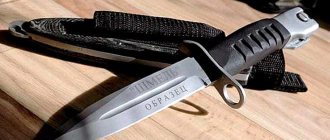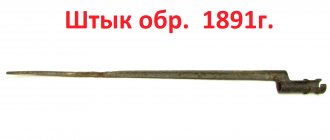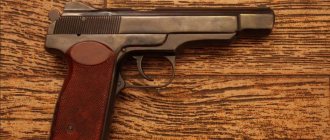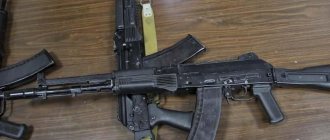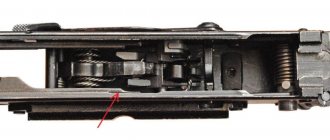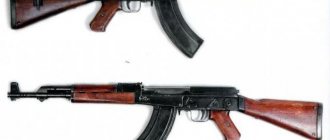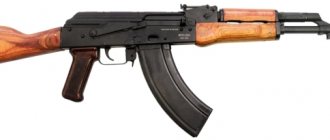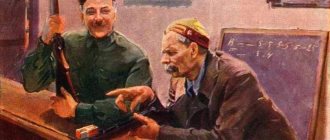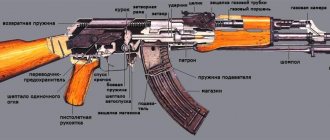To date, 70 million copies of Kalashnikov assault rifles have been adopted in different countries of the world, which is approximately a fifth of the shooting market. This weapon is rightfully considered one of the best in the world. However, the Kalashnikov Concern produces it not only for military and police use, but also for civilian use. In the latter case, special models are used that are made taking into account the requirements of current legislation. Many gun lovers would like to know whether there is a real opportunity to purchase this or that model and what price they can expect.
Characteristics of the AK-47
| Characteristic | Parameter |
| Caliber | 7.62 mm |
| Firing modes | single/automatic |
| Weapon length | 87 cm |
| Length including bayonet | 107 cm |
| Store capacity | 30 rounds |
| Weight without cartridges | 4.07 kg |
| Weight with loaded magazine | 4.7 kg |
| Effective firing range | 650 m |
| Weapon rate of fire | 660 rounds per minute |
| Effective shot range on a tall figure | 550 m |
| Rifling in the barrel | 4 things. with a pitch of 240 mm |
| Chuck used | 7.62 x 39 mm |
| Initial bullet speed | 715 m/s |
The Kalashnikov assault rifle was created in the forties of the 20th century. At first, the weak point was the accuracy of fire. However, at that time it was not considered the most important characteristic. Since its creation, the machine has had excellent reliability, reliability, guaranteed service life, mechanical strength, and others. According to them, this weapon was one of the best in the world.
AKM and AKS-74U
Work on improving weapons did not stop, and in new models the problem with accuracy was solved. For example, the AKM, when firing at 800 m, showed a spread of 64 cm vertically and 90 cm horizontally. For the AK-74, these characteristics are respectively 48 and 64 cm.
If shooting is carried out with single shots from a prone position, then a good shooter can easily hit a head figure at a distance of 100 m, a waist or running figure at a distance of 350 m. If a distance of 800 m is considered, then to hit a running figure it will take 4 single shots, and short bursts - for 9 rounds.
This weapon uses a standard magazine that holds 30 rounds. It is double row. The use of machine guns is available, holding 40 or 75 rounds of 7.62 caliber, respectively, for the sector or drum version. A magazine that holds 45 rounds of 5.45mm rounds is also available. Magazines for this machine gun are characterized by high reliability and trouble-free supply of cartridges.
It uses a sighting device consisting of a sight located in the central part of the weapon and a front sight. The sight is designed for shooting at a distance of up to 800 m. The front sight is located above the front of the barrel and is protected from the sides. It can be adjusted if necessary to set up normal combat. Some models provide the possibility of additionally installing a night sight or optical sight on a special bracket.
The AK-47 assault rifle, the most famous representative of this family of weapons, has gradually revealed a number of shortcomings over the years, work on which led to the emergence of new models of weapons.
One of the problems was the use of metal parts in its design - this made the machine too massive. Locking occurs through the cutouts of the steel box, and not through the extension of the barrel, as in more modern models. The collapsible receiver prevents the use of modern body kit mounts, which reduces the possibilities for effective shooting.
The manufacturer is constantly working to improve this weapon. The AK-12 uses more modern approaches to design. For example, here the receiver, when opened, hinges upward and forward. Its design allows the installation of a Picatinny rail, on which you can install sights and other types of body kit.
This model is almost the same in weight as the previous model, but all the necessary improvements have been introduced into it, determined by the modern level of development of weapons technology.
The birth of the Kalashnikov assault rifle - a legendary weapon
It cannot be said that the Kalashnikov assault rifle immediately turned out to be a perfect product. The predecessor of the legendary AK-46 weapon, with which the young and ambitious designer took part in the competition, did not live up to the hopes placed on it. The first prototype was not reliable and was inferior to its competitors in many respects. The main competitors of Kalashnikov’s brainchild were the Sudaev and Tokarev automatic rifles, which underwent military tests back in wartime. Kalashnikov, whose machine gun design failed the tests, got a chance to refine his product.
The next year, the young designer provided the competition commission with a modified, improved model of his automatic rifle. The results of the revision were mixed. The design of the product has become more reliable, but the shooting characteristics of the automatic rifle have caused a lot of controversy. During automatic firing, the accuracy of fire was poor. Having given time to bring the firing parameters of the model to the required standards during operation, the high military commission focused its attention on the M.T. Kalashnikov. Competing models were inferior to the AK in key parameters. This played a decisive role in the decision to adopt the new automatic rifle for service.
Since 1949, the AK automatic rifle began to enter service with army units of the Soviet Army. Abroad, new small arms were assigned the index AK-47, based on the year the model was created.
The new weapon was very far from the white swan that the Kalashnikov assault rifle became over time. The product turned out to be bulky and heavy. The reason for the large weight of the first AK models was the turned receiver, made by milling steel blanks. Compared to the German Stg-44 assault rifle, to which the Soviet AK is often compared, the Kalashnikov weapon was lighter. The mass of the Soviet modification was 4.3 kg. When equipped, plus a bayonet and a full magazine, the weapon already weighed 4.8 kg. The length of the weapon from the end of the butt to the end of the barrel was 870 mm.
Despite its rather impressive dimensions and weight, the Kalashnikov automatic carbine, or AK, had excellent firing characteristics. The rate of fire was 100 rounds per minute when firing in bursts, and up to 40 rounds per minute when firing alone. Unlike its predecessors, front-line submachine guns, which fired at a pistol shot distance, the new product was capable of conducting aimed fire at a distance of 800 m.
Is it possible to buy a Kalashnikov assault rifle in Russia?
The Kalashnikov assault rifle has gained wide popularity. Many gun lovers would like to purchase one for themselves. However, it must be borne in mind that military weapons are not intended for civilian use. Despite the fact that this machine gun is very common all over the world, a civilian cannot legally buy it.
If you try to do this in circumvention of the law, then the buyer will get into serious trouble, since we are talking about a serious punishment. The Kalashnikov Concern has released variants for those who wish, in which design changes have been made that meet the legal requirements for civilian weapons.
Why did the USSR abandon the most powerful cartridge for the Kalashnikov assault rifle AKM 7.62 x 39 mm
The AK assault rifle chambered for the new 5.45 x 39 mm cartridges was capable of destroying the enemy at a distance of up to 400 meters, becoming one of the most formidable assault rifles in the world. The Russian Army's main assault rifle, the AKM, was chambered in 7.62 x 39 mm, capable of penetrating a brick wall from 100 meters. But in the early 1970s, the decision was made to abandon them in favor of an intermediate 5.45 x 39 mm cartridge with low recoil.
What was the reason for this decision?
Reasons for replacing the main rifle cartridge in the Russian army
“Initially, the concept of a small-caliber high-velocity cartridge in Russia was developed by the famous weapons design engineer Vladimir Fedorov, who created the Fedorov Avtomat, which, according to many, was the first assault rifle in history. I personally believe that it was the first combat rifle in history, but not quite an assault rifle as we know today,” Vladimir Onokoy, a Russian defense industry specialist, small arms instructor and gunsmith, said in an interview.
What's important, Onokoya says, is that the Fedorov Avtomat used a patented small-bore 6.5mm cartridge, so in some ways it was 50 years ahead of its time. Unfortunately, the First World War ruined the project.
“The next time Russian weapons designers turned to the idea of a small-caliber, high-velocity cartridge was in the 1960s. Inspired by the American 5.56x45mm cartridge, they followed the same concept, developing a cartridge with less recoil, lighter and therefore more comfortable for the soldier, with a better ballistic trajectory, making it easier to shoot at long and medium ranges. The new cartridge was also more effective at penetrating body armor due to the higher velocity of the light bullet."
, he noted.
The project was successful, and in 1974 the new machine gun, originally called the A-3, was officially adopted as the AK-74 (6P20).
There were several reasons for changing ammunition. The 7.62 x 39 mm AKM was a powerful weapon, but the recoil and dispersion of bullets when fired was too great - a more accurate weapon was required. In addition, with a firing range of 200-250 meters, the effective lethal range (in other words, the distance at which the shooter can reliably destroy the enemy) was insufficient, and the 5.45 x 39 mm cartridge increased the lethal range of the machine gun by 100 meters.
Please note: Why did the first “firearm” put an end to the dominance of armor if it did not penetrate it?
And finally, it was necessary to reduce the weight of the machine gun and ammunition (the new cartridge and the AK-74M adapted to it became lighter and allowed the soldier to take an additional four full magazines).
“When developing a new cartridge, the designers took into account the American experience in Vietnam. The Americans used a 5.56x39 mm cartridge with similar parameters and fired from long distances at the enemy armed with AKs. Our weapon developers took this experience into account when creating new weapons,”
- said an employee of one of the Russian military and law enforcement agencies.
Despite this, only the USSR switched to new ammunition. Other countries that had the AKM continued to use the 7.62 x 39mm cartridge, including India, Pakistan, Warsaw Pact countries, African countries, China to some extent, and many others.
“If we have an operation in the Middle East, we will take a 7.62 x 39 mm AK. It is convenient because ammunition of this caliber can be obtained from killed militants. If this is an operation inside Russia, then we will most likely take a 5.45 x 39 mm AK with us."
, added a member of the unit.
Data
Each cartridge has its own objective advantages and disadvantages. For example, the weight of a 7.62 x 39 mm cartridge is 16.2 grams, and 5.45 - 10.3 grams. For comparison, the weight of 240 rounds of 5.45 caliber (equivalent to eight magazines) is 1.4 kg less than the weight of the same number of 7.62 caliber rounds. The range at which the 5.45 bullet retains its lethal force is 100 meters longer, while the recoil of the rifle is significantly reduced.
However, the penetration power of 5.42 is less than that of 7.62. Additionally, the 5.45 is much more likely to ricochet off an obstacle.
#Russian weapons #AK-47 assault rifle
More interesting articles here: Weapons.
Article source: Why the USSR abandoned the most powerful cartridge for the Kalashnikov AKM 7.62 x 39 mm.
- Previous: New Russian plc pistol will enter the world market in 2022
- Next: New Russian rifle capable of fighting on land and under water
What types of Kalashnikov assault rifles can be bought legally
Ask a Question
Question to the expert
Can a civilian legally purchase an assault weapon?
This is impossible, as it violates the requirements of current legislation.
Do I need special permission to purchase a weight-dimensional model?
No, because it is not actually a firearm.
The acquisition of weapons is possible in cases where changes have been made to them, as a result of which they become fully compliant with legal requirements. For example, civilian weapons should not be able to fire automatically. The manufacturer must not only block it, but also make it so that the user cannot restore it on his own.
The exception to this rule is assault rifles, which are designed to fire blank cartridges only. They have the ability to shoot in bursts.
The Kalashnikov Concern produces several types of these, depending on the purpose for which the purchase is needed. The use of weapons for civilian purposes is varied, and each option may have its own characteristics.
For a collector, a mass-dimensional model may be suitable. It exactly copies the appearance of the machine. However, he can also purchase a weapon version designed to fire blank cartridges.
Model for firing blank cartridges
There are weapons of this type designed for hunters. Smooth-bore and rifled-bore options are available. For them, you need to obtain the appropriate documents. It must be borne in mind that rifled weapons are allowed to be used only by those who have the legal experience of owning a smooth-bore weapon.
There is a wide variety of smoothbore carbines. Some are like this, while having a rifled part of the barrel. An example is the “paradox” barrel. There are also models that use Lancaster drilling, which allows you to increase the effective firing range.
AK-366 Lancaster
To obtain a license to purchase shotguns, you must complete the following steps:
- Get a hunting license.
- Pass a medical examination.
- Complete courses that teach the storage and use of hunting weapons.
- You need to buy a safe designed to store it.
- In order to receive a document, you must submit a corresponding application.
- Obtaining a license.
Having this document, you can purchase a smooth-bore hunting weapon. After using it for five years, you can obtain permission to purchase rifled hunting weapons.
The machine gun is in demand among those who study it and hope to take part in historical reconstructions. Having a high-quality copy in hand, you can master assembly and disassembly, understand how the weapon works, and learn how to operate a machine gun.
Kalashnikov assault rifle AK-74M
| AK-74M |
At the end of the 1980s, Soviet gunsmiths were tasked with creating a new assault rifle that would reflect the accumulated combat experience of using 5.45-mm Kalashnikov assault rifles of the 1974 model AK-74 in Afghanistan. The Afghan war revealed the need to make some changes to the design of these weapons. First of all, this concerned strengthening the receiver, receiver cover, and metal folding stock in the AKS-74.
| Caliber, mm | 5.45x39 |
| Length, mm - butt unfolded - butt folded | 943 700 |
| Height, mm | 195 |
| Width, mm | 70 |
| Barrel length, mm | 415 |
| Weight without magazine, kg | 3.4 |
| Store, count. cartridges | 30 |
| Initial bullet speed, m/s | 900 |
| Sighting range, m | 1000 |
| Rate of fire, rds/min | 600 |
In the mid-1980s, designers at the Izhevsk Machine-Building Plant developed several models of the universal modified Kalashnikov assault rifle A-60 and A-61.
On the basis of the A-60 and A-61, one of the successful variants of the 5.45 mm Kalashnikov AK-74M assault rifle was developed. This weapon replaced several models of the Kalashnikov assault rifle: AK-74, AK-74N, AKS-74 and AKS-74N.
The design of the Kalashnikov AK-74M assault rifle almost completely repeats the design of the AK-74 and, from the point of view of the internal structure, has no fundamental differences.
The AK-74 M automatic system operates on the principle of removing powder gases from the barrel. Locking the barrel bore is done by turning the bolt onto two lugs. The trigger mechanism allows for single and automatic fire. The safety switch box is located on the right side of the receiver. Mechanical sights consist of an open-type sector sight, designed for a range of up to 1000 m, and a front sight. The weapon is fed with cartridges from standard 30-round detachable sector-type box magazines.
However, the AK-74M, while retaining all the best qualities of Kalashnikov assault rifles, acquired a number of new ones that significantly improved its combat and operational characteristics.
The AK-74M stock is folded.
The main feature of the new Kalashnikov model is a folding stock made of black plastic on the left side, replacing the metal folding AKS-74.
The new stock, which is lighter than metal, is structurally similar to the permanent plastic AK-74 from 1986-1990. Made of plastic, it almost completely eliminated any discomfort for shooters when shooting in low and high temperatures. The improved design of the butt eliminated the weakening of the riveted joints of the butt and its deformation when falling from a height. On the left side of the butt there is a rectangular groove into which, when folded, the bar of a standard sight mounting unit fits. mounting the NSPU-3 night vision sight on the AK-74M
On the left side of the AK-74M receiver there is a universal rail for mounting night, optical, and collimator universal sights that use the stereoscopic effect (i.e., when aiming, the shooter constantly watches battlefield with two eyes in a real space scale).
The handguard and the barrel lining of the gas tube of the AK-74M assault rifle were also made of glass-filled polyamide AG-4V, which has increased resistance to mechanical damage. The heat transfer coefficient of the new material is no higher than that of wood, which almost completely eliminated hand burns during prolonged shooting, while the longitudinal ribs on the forend made it possible to hold the weapon more conveniently and firmly when conducting aimed fire.
The not entirely successful muzzle brake-compensator of the AK-74 necessitated some changes to its design. The new two-chamber muzzle brake-compensator of the AK-74M has open chambers, which made it possible to clean it without separating it from the barrel. The “sway” of the muzzle brake during shooting was eliminated by increasing the seating area.
The receiver cover (without stiffening ribs) has been significantly strengthened, which has reduced the likelihood of its mechanical deformation, especially when struck in hand-to-hand combat.
| AK-74M with a GP-30 grenade launcher installed |
A more successful design of the return spring guide rod, which received a lock, made it possible to fire from the GP-25 and GP-30 under-barrel grenade launcher without installing additional fastening for the receiver cover, which was necessary in the AK-74 - GP-25 automatic grenade launcher complex.
The design of the modernized AK-74M assault rifle ensures high reliability of automatic operation - up to 25,000 rounds. The version of the AK-74M assault rifle with the NSPU-3 night sight weighs 5.5 kg without a magazine, has a width of 140 mm, and a firing range with a night sight of up to 300 m.
| AK-74M with installed NSPU-3 night sight, GP-25 under-barrel grenade launcher and bayonet |
In general, the design of the AK-74M embodied the idea of a “universal” assault rifle, replacing four models at once - AK-74, AK-74N, AKS-74 and AKS-74N.
The new AK 74 M assault rifle was planned to be put into production at the Izhevsk Machine-Building Plant, and the RPK-74M light machine gun created on its basis at the Vyatsko-Polyansky Machine-Building Plant back in 1991, however, changes in first the political and then the economic situation associated with the collapse of the USSR led to freeze the production of new weapons. A sharp decline in government orders for the purchase of weapons led to an almost complete freeze of this program. And only the beginning of the first Chechen war led to the fact that the Government of the Russian Federation in 1995 was forced to adopt the modernized 5.45-mm AK-74M assault rifle and the RPK-74M light machine gun into service with the army and law enforcement agencies.
| AK-74M incomplete disassembly |
What analogue of Kalashnikov can be bought legally?
Saiga-MK is available in 5.45 and 7.62 mm caliber versions. This rifled weapon is very similar in appearance to a Kalashnikov assault rifle. The AK-TR3 is also available for sale. This model is an exact copy of the modern Kalashnikov AK-12 assault rifle, modified in such a way that civilian use is possible.
AK-TR3
Copies of modern machine guns are adapted to work with a light and sound cartridge. The weapon fires blank cartridges, exactly simulating the shooting of original military weapons.
Models made from decommissioned copies may appear on sale. Outwardly, they are indistinguishable from military weapons, but they cannot fire.
Soviet intermediate cartridge 7.62x39
Currently, one of the most famous cartridges in the world is the Soviet 7.62x39 caliber cartridge, which is inextricably linked with the fate of the Kalashnikov assault rifle. The Kalashnikov assault rifle, adopted for service in 1949, was created specifically for this ammunition. Only in the early 1970s was it replaced by a new 5.45x39 mm cartridge, but to this day the 7.62x39 mm cartridge remains one of the most common and widespread in the world. It is considered the third most powerful among all machine gun cartridges.
Experts in the history of firearms agree that the Soviet 7.62×39 mm cartridge appeared under the influence of the German 7.92×33 mm or 8 mm “Kurz” cartridge. In essence, the Soviet cartridge model became an improved version of the German concept in terms of its shape and efficiency of use. The 8 mm Kurz cartridge was used for the first time during World War II on the Eastern Front, and both German and Soviet troops assessed its effectiveness quite well. Thus, the German intermediate cartridge and small arms for it gave impetus to Soviet research in this area.
The first work on the development of an intermediate cartridge in the Soviet Union began back in 1939, but the question of their creation was raised even earlier. To study this issue, a 5.45 mm caliber cartridge was created in the USSR, and even an order was issued to create a self-loading rifle for a new cartridge. But in connection with the outbreak of the Great Patriotic War, Soviet designers temporarily switched to more relevant types of work. As a result, they returned to the creation of an intermediate cartridge only in 1943, after the participants of the Technical Council of the NKV (People's Commissariat of Armaments) became acquainted with captured samples of German weapons captured at the front, as well as the American M1 self-loading carbine provided by the USSR for review.
Most of all, the attention of Soviet gunsmiths was attracted by the new German cartridge of 7.92x33 mm caliber, specially designed for the MKV 42 [N] carbine, which was tested in the active army. This cartridge with a total length of 48 mm (33 mm sleeve length) weighed 16.2 grams. With a mass of the bullet itself of 8.2 grams and an initial speed of about 700 m/s, this cartridge provided targeted shooting at a range of up to 800 meters. At the meeting, it was decided that it was necessary to create a cartridge of reduced power in order to replace the rifle cartridge in such types of weapons as a light machine gun and a self-loading (automatic) rifle, as well as new types of small arms specially created for it. The new intermediate cartridge could become the basis for the development of lightweight individual automatic weapons with a greater firing range than submachine guns. OKB-44 was appointed responsible for the creation of the new cartridge, which in the future became NII-44, and in 1966 was reorganized into TsNIITOCHMASH. To determine the optimal characteristics of the new ammunition, calculations were made to select the mass and velocity of the bullet for calibers 5.6 mm, 6.5 mm and 7.62 mm. These calibers were chosen as the most frequently encountered in practice.
The new Soviet 7.62 mm cartridge had the following requirements: the cartridge case must have a modern shape - without a flange; weight and dimensions are smaller than those of a rifle cartridge; cartridge power is 20% less (compared to a rifle); the bullet energy at a distance of 1000 meters must be no less than 245 J. The intermediate cartridge was created for use in a light machine gun, a self-loading rifle and an automatic carbine-machine gun. Small arms created for the new cartridge were supposed to be lighter, including by reducing the barrel length. For the same purpose, it was considered possible to use thin rifle barrels for submachine gun carbines (machine guns) without fear that they would overheat, since the shooting was mainly supposed to be carried out in single shots and only in the most critical moments of the battle - in bursts.
Taking as their starting point the fact that flat trajectory is one of the main characteristics for the new cartridge, OKB-44 specialists decided from the very beginning of development that the new cartridge should be better than the German one. For the German 7.92x33 mm cartridge, the direct shot range (DPV) was 300 meters; for the Soviet cartridge, the DPV was taken equal to 325 meters. Already on September 3, 1943, the NKV Technical Council reviewed the first two versions of the cartridge. As a result, a choice was made in favor of one of them, which later received the designation 7.62 mm cartridge of the 1943 model. After the September meeting, which was attended by all weapons design bureaus and the research site for small arms and mortar weapons of the GAU (NIPSMVO), the USSR began the development of new types of weapons chambered for a promising machine gun cartridge.
Already in December 1943, the first batch of new cartridges with a bullet with a lead core (the cartridge was assigned the index 57-N-231) was tested at the test site. After minor modifications, starting in March 1944, production of an experimental batch of 7.62 mm cartridges of the 1943 model began. The original version of this cartridge had a 41 mm long sleeve and a bullet with a lead core with a short head and without a rear cone.
The small arms designed at the same time for the new cartridge—the automatic carbine (automatic) and the self-loading carbine—were primarily intended for firing single shots. It was assumed that automatic fire would be needed only in close combat at a range of 100-200 meters. Based on this assumption, during the development of the 7.62 mm cartridge of the 1943 model, the main attention was paid to ensuring the necessary accuracy of fire when firing single shots, the direct shot range and the penetrating effect of the bullet. Nobody demanded high accuracy of fire when using automatic fire from the new cartridge. However, later, when the AK was adopted by the Soviet army, firing in bursts began to be considered the main type of firing from a machine gun to increase the density of fire (the number of bullets per linear meter per minute). Regardless of the distance of the target. To be fair, it can be noted that the probability of hitting a target when firing in bursts increased, but only slightly, while the consumption of ammunition increased in proportion to the length of the burst.
In 1944, when gunsmiths received the results of the first tests of the new cartridge, work began on its improvement in order to increase penetration and accuracy. As part of this work, the head (ogival) part of the bullet was lengthened. This made it possible to improve the ballistic coefficient while maintaining a constant bullet mass. The bullet also had a rear cone introduced, which was supposed to reduce air resistance during the flight of the bullet. Moreover, as it was believed then, not only at subsonic bullet flight speeds (when firing over a long range), but also at supersonic flight speeds. In order to maintain the overall length of the cartridge, the cartridge case neck had to be shortened by 2 mm, while the depth of the bullet in the case was increased. As a result, the sleeve acquired a final length of 38.7 mm (when designating a 7.62x39 cartridge, the length of the sleeve is indicated in round numbers). The next stage of work was replacing the lead core with a steel one.
The bullet, which had a steel core, received the designation “surrogated”. The length of such a bullet increased from 22.8 mm in the first version to 26.8 mm. The main argument in favor of using low-carbon steel for the manufacture of the core was not so much the increase in the penetration effect of the ammunition, but the savings in lead (up to 50%), which was then in short supply, and the greater manufacturability of core stamping. At the same time, its manufacturing technology was borrowed from the cartridge of the popular TT pistol. It should be noted here that in those years the main criterion for the penetrating effect of a bullet was the assessment of the possibility of penetrating an army steel helmet at a distance of 800-1000 meters. By mid-1947, all the shortcomings noted during testing on the 7.62-mm cartridge of the 1943 model with a conventional bullet had been eliminated. The GAU decided to produce a series of such cartridges and prototype weapons for military testing.
In order to increase the tactical capabilities of the small arms being developed, as well as based on the existing experience in creating 7.62-mm rifle cartridges for various purposes, along with a cartridge equipped with a conventional bullet, a set of works was carried out to create cartridges of the 1943 model with special bullets: armor-piercing -incendiary (created in 1944), tracer and incendiary (created in 1948). In 1949, simultaneously with the Kalashnikov assault rifle, 7.62-mm cartridges of the 1943 model with all the listed types of bullets were also adopted. Subsequently, the improvement of the 1943 model cartridge with an ordinary bullet equipped with a steel core was carried out in the direction of increasing its penetrating effect (to ensure the destruction of enemy manpower in personal armor), and the tracer cartridge in the direction of further increasing the burning time of the tracer and slowing down the start time its combustion. In the improvement of these cartridges, the use of new types of gunpowder as charges, in particular spherical grained gunpowder, played a great role.
The priority in the creation of this type of gunpowder belonged to the United States. The main advantage of spherical grained gunpowder was that it provided high gravimetric density (filling density of the cartridge case) - about 0.85 g/cm3, high manufacturability and increased progressiveness of combustion. All this together made it possible, with an equal size of the charging chamber, to provide the bullet with greater muzzle energy or, with equal muzzle energy, to reduce the size of the cartridge case.
Soviet 7.62 mm cartridges: rifle, intermediate and pistol
Initially, the new 7.62×39 cartridge was produced only with a bimetallic sleeve - steel coated with tombak. However, in 1948, due to difficulties in obtaining bimetal, the bulk of which had previously been supplied to the Soviet Union from the United States under Lend-Lease, it was decided to produce the automatic cartridge case from brass-plated steel. The brass plating process, which the USSR borrowed from German industry, involved the use of highly toxic substances. Therefore, after the production of bimetal was mastered in the USSR in 1952, machine gun cartridges again began to be produced from this material. Subsequently, around the beginning of the 60s of the last century, at some Soviet enterprises the production of varnished steel sleeves (coated with green varnish) was mastered, which ensured significant savings in tombac. Already in our time, the production of steel sleeves with a polymer coating (a special water-polymer solution) was successfully mastered, which significantly reduced the harmfulness of production.
The range of 7.62x39 mm ammunition included cartridges with both a conventional bullet with a steel core PS (index 57-H-231) and special-purpose bullets. Such ammunition included: armor-piercing incendiary (BZ, index 57-BZ-231), incendiary (Z, index 57-Z-231), tracer (T-45, index 57-T-231 P), armor-piercing (BP, index 7 N23), as well as a 7.62-mm cartridge of the 1943 model with a reduced bullet speed (US, index 57-N-231 U). For example, a bullet with a steel core could pierce a soldier’s steel helmet (helmet) at a distance of 900 meters, and an armor-piercing incendiary bullet at a distance of up to 1100 meters. The 7 mm thick armor plate armor-piercing incendiary bullet confidently penetrated at a distance of up to 200 meters. The use of tracer bullets when firing at moving targets provided the best observation of the shooting results and simplified the aiming of the weapon at the target, as well as the target designation process. Shooting at enemy personnel located in cars, armored personnel carriers and motorcycles, as a rule, was carried out with cartridges with armor-piercing incendiary bullets and bullets with a steel core (in a 1:1 ratio). In addition, the set of 7.62-mm caliber ammunition of the 1943 model also included auxiliary cartridges - blank (57-X-231) and training (index 57-N-231UCH). The difference between these cartridges is that training cartridges are used to teach soldiers how to load weapons, load magazines and fire a shot; such cartridges do not contain a powder charge. At the same time, blank cartridges are designed to simulate the sound of a shot during soldier training, as well as for gun salutes.
Cartridge on the civilian weapons market
The 7.62x39 mm cartridge is loaded into a relatively short - 39 mm long - wafer-shaped, conical sleeve. While the “big brother” of this cartridge - the Russian standard rifle cartridge 7.62x54R is equipped with a flanged case, and therefore is not very well suited for use in automatic weapons - the 7.62x39 mm caliber cartridges are specially optimized for semi-automatic and automatic firearms . The original 7.62x39 mm cartridge uses a pointed jacketed bullet weighing 8 grams. Its initial flight speed is about 720 m/s with an initial energy level of approximately 1960 J.
Developed back in 1943, the cartridge was originally intended for military use only. Under it, the USSR immediately began developing a whole family of various firearms - self-loading and repeating carbines, machine guns and light machine guns. The 7.62x39mm cartridge was an intermediate cartridge for lightweight "assault" rifles that would be easier to handle and could serve soldiers in the ever-changing world of military tactics. The ballistic characteristics of this ammunition were developed based on the destruction of human targets only, without any focus on hunting.
Massive sales of the 7.62x39 mm cartridge in the countries of the former Warsaw Pact, as well as in countries that were formerly part of the Soviet Union, significantly influenced their availability on the international civilian weapons market - both for hunting and for sporting purposes. Huge quantities of this ammunition appeared on the market at the end of the Cold War. The global market is overflowing with offers chambered for the 7.62×39 mm cartridge, ranging from classic military models, for example, AK and SKS, including their civilian versions, such as the Ruger Mini-30, and more modern sporting rifles made in the USA. Some of them combine the classic American AR-15 design with a typically Russian 7.62x39mm caliber.
Some 7.62x39mm bolt action rifles designed for target shooting and hunting are also available on the market. Mainly, such models are produced in Eastern Europe, for example the popular Czech hunting rifles of the CZ series. Although some versions of such rifles are also produced by Western companies, for example the Italian manufacturer Sabatti, which has thus diversified its product line.
And although the 7.62x39 mm cartridge is definitely not the best option in terms of firing accuracy, its characteristics are more than sufficient for shooting at short distances, especially when it comes to shooting at distances up to 100 meters. At the same time, it is undesirable to use a weapon of this caliber for shooting at long distances at quite serious game, since this caliber does not have enough energy for a reliable killing effect. The 7.62x39mm caliber can be considered a viable option when hunting medium-sized game, such as roe deer, at a target distance of no more than 150 meters. Of course, this is not a cartridge for big game hunting, because its killing power may not be enough to guarantee the effectiveness of the hunter’s first shot.
Despite these features, 7.62x39 mm cartridges are still popular in Europe and are used with many self-loading rifles that are used for wild boar hunting. And in the USA, this cartridge has become very popular when hunting various pests, as well as for controlling the numbers of foxes, coyotes and other small game. The advantage is that recoil when firing 7.62x39 mm cartridges is minimal. This makes the cartridge very popular and enjoyable for use in training and sports shooting, as well as popular in some Western countries for recreational shooting. The use of such ammunition does not cause fatigue to the shooter, and loading it independently is quite simple.
Sources of information: https://weapon.at.ua/board/11-1-0-31 https://www.dogswar.ru/boepripasy/41-patrony/7581-promejytochnyi-patro.html https://www .all4shooters.com/ru/glavnaya/boyepripasy/2015-statyi/Boyepripasy-7-62x39mm-vintovochnyy-kalibr-dlya-okhoty-i-sporta Materials from free sources
Responsibility for illegal arms trafficking
Those who illegally acquired the combat version of the Kalashnikov assault rifle are subject to the Criminal Code of the Russian Federation. Article 222 reads as follows:
- Acquisition in any form is illegal: purchase, receipt as a gift, in payment of a debt, in exchange or in any other way. If a person found such a copy and kept it for himself, this would also be a punishable offense.
- You cannot store such weapons, carry them with you, or transport them anywhere.
- It is prohibited to sell the combat assault rifle or transfer it in any other way to other private individuals.
- For such violations, you can be imprisoned for up to 3 years, receive forced labor for up to 4 years, pay a fine of up to 80,000 rubles, and give income for up to three months to the state.
If these actions were carried out by conspiracy or by a group of persons, the severity of the punishment will increase. If the actions were committed by an organized group, the punishment will become even more severe. It is a criminal offense to illegally sell civilian weapons. If a person falls into the hands of a weapon discussed in this article of the Criminal Code, he has the right to voluntarily hand it over to law enforcement agencies. If it was seized during investigative actions, then this cannot be considered a voluntary surrender.
The Kalashnikov assault rifle has gained enormous popularity over the years of its existence. Civilian analogues of these weapons are produced, which have retained the external similarity and main characteristics of the original models. They are available for legal purchase and use in everyday life.
